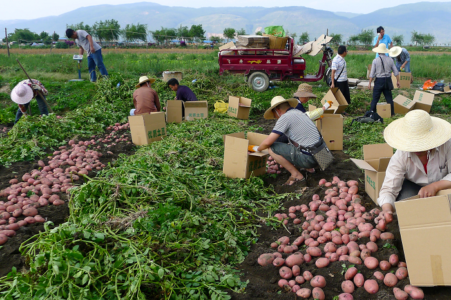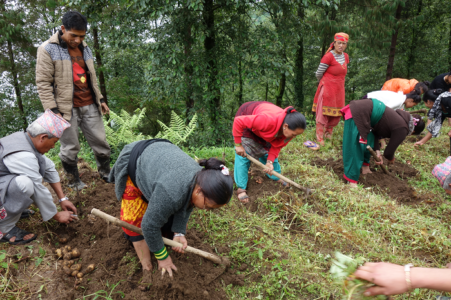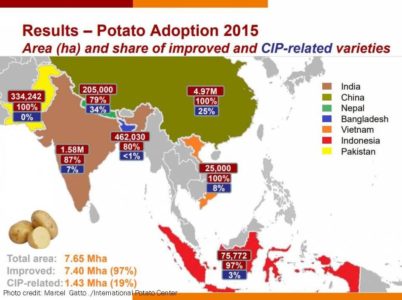
The potato is one of the most important crops in Asia, contributing to the food security and incomes of millions of families. Asian farmers produced almost 196 million metric tons of potatoes in 2017—about half of the global harvest—and many of those potatoes were bred by scientists at the International Potato Center (CIP), or using CIP germplasm, over the course of the last four decades.
The Center has bred or contributed to the development of dozens of potato varieties popular in Asia, and a study of seven major Asian potato-producing countries determined that almost 3 million farming households grow varieties that were either bred directly by CIP or in cooperation with national programs.
The study, published in 2018, assessed the adoption rates of 491 improved potato varieties released in Bangladesh, China, India, Indonesia, Nepal, Pakistan and Vietnam between 1952 and 2015. Researchers determined that 210 of those varieties had been adopted by farmers and occupied 97% of the land dedicated to potato in those countries.
An estimated 15.3 million farming households in the seven countries grow potatoes on a total of 7.6 million hectares. Sixty-three CIP-related varieties are grown on 1.43 million hectares—19% of the total land area dedicated to potato production – by 2.93 million farming families, primarily in China. The researchers estimated that those varieties benefit a total of 10.2 million people.
The most popular varieties combine taste and cooking characteristics desired by farmers and consumers with traits increasing disease-resistance and heat- and drought-tolerance. Those attributes save farmers money they would otherwise spend on agrochemicals or certified seed potatoes, contributing to improved incomes. Though researchers were unable to quantify the benefits provided to Asian farmers by the 63 varieties, a 2013 adoption assessment in Peru found that farmers who planted CIP-bred varieties harvested about 10% more potatoes per hectare than farmers who grew other improved varieties.

“This research validates the decades of work by breeders using genetic diversity conserved in the CIP genebank to develop improved potato varieties that meet the needs of small-scale farmers and consumers in Asia and other regions,” said Oscar Ortiz, CIP Deputy Director General for Research and Development.
CIP-related varieties have been especially popular in Nepal, where 34% of the total land area dedicated to potato production was planted with them in 2015. However, they’ve had a much bigger impact in China, the world’s top potato producer. The Center has been active in China since 1978, when it sent a potato clone to Chinese scientists called CIP 24, which subsequently became one of the country’s most popular varieties.
Chinese farmers now grow 35 varieties that are the results of CIP-China cooperation, which together cover about 25% of the country’s potato farmland. They include three of China’s 10 most cultivated potato varieties. An economic surplus analysis of the impact of one such variety, Cooperation 88, estimated its benefits to be between USD 2.84 and 3.73 billion to producers and consumers in Yunnan province alone between 1996 and 2015.

The Center’s potato agri-food systems program is working with government and private sector partners in Asia to extend such benefits to more people through the development and dissemination of productive, nutritious and climate-smart potato varieties. The releases of heat-tolerant and virus-resistant potato varieties Kufri-Lima in India and KT-1 in Vietnam are recent results of long-term efforts to breed resilient and productive potatoes that can improve the food security and incomes of the region’s smallholder families.
“CIP’s breeding efforts and international cooperation continue to make important contributions to the lives of potato farmers in Asia and across the Global South, but to meet the challenges of climate change and population growth, we need to breed and deploy more climate-resilient, consumer-demanded varieties faster that ever. We aim to use the power of genomics and big data more intensively, while applying tools developed by the CGIAR Excellence in Breeding Platform, to achieve this,” Ortiz said.
The research was funded by the Bill & Melinda Gates Foundation, CGIAR Research Program on Roots, Tubers, and Bananas (RTB), CGIAR Standing Panel of Impact Assessment, and Michigan State University.
Read more in the CGIAR 2018 Performance Report
Read the adoption assessment
